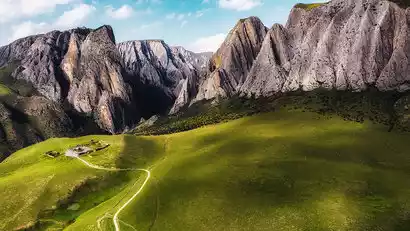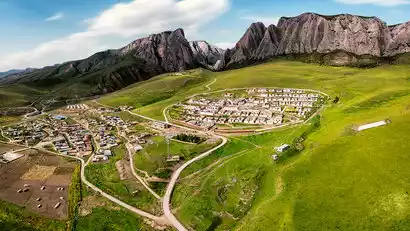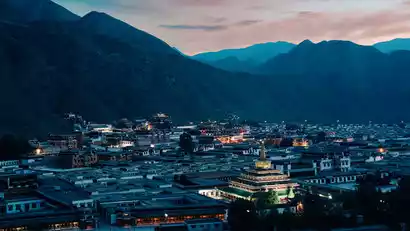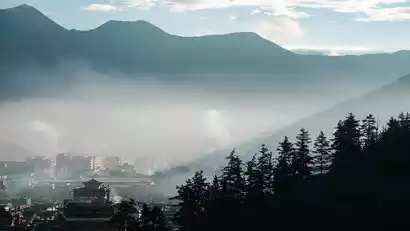Day 1: Anywhere → or → Lanzhou ★Gathering day
All day
Today, all tourists will arrive in Lanzhou from all over the country. You can choose your preferred method of transportation and rest at your hotel upon arrival. For photography, consider visiting our mother river, the Yellow River. Head to Zhongshan Bridge, the first bridge over the Yellow River, and take photos of the ancient waterwheels, the iconic sculpture of the Yellow River Mother, and, of course, the sheepskin raft, an ancient means of crossing the river. After capturing the sunset, the nightscape of the Yellow River is another great subject.
Alternatively, visit the Gansu Provincial Museum (closed on Mondays; ID required) or the Xiguan Grand Mosque. Of course, you can't miss the famous Lanzhou ramen (actually Lanzhou beef noodles; we recommend Ma Youbu, Ma Zilu, or Junle on Yizhichuanzhong Street) and Muslim snacks, such as niangpi (stuffed rice noodle wrappers) and sweet fermented mash (sweet fermented rice flour). We recommend visiting Zhengning Road Snack Street or Dazhong Lane Food Street. During free time, please be careful.


Day 2 Lanzhou → Xiahe → Labrang Monastery → Langmusi
·morning
After breakfast, we'll depart Lanzhou and begin our long-awaited photography trip. We'll travel by highway to Xiahe, passing through Linxia, the Little Mecca of the East, and into Tibet. After approximately four hours, we'll arrive in Xiahe County for lunch. We'll then enter Labrang Monastery, one of the six principal monasteries of the Gelugpa (Yellow Sect) of Tibetan Buddhism. We'll walk along the prayer corridor, gently pushing a prayer wheel while chanting the six-syllable mantra: "Om, Ma, Ni, Ba, Mi, Hong," and filming the lives of Tibetan believers.
·afternoon
We then traveled to Langmusi Town, where we took in the sights of Tibetan life on the vast grasslands: smoke rising from cooking fires, tents rising from the sky. The blue sky and pastures, the herders and their cattle and sheep, the fine wine and song and dance, the soul connected to the Buddhist kingdom. The enchanting Gannan grasslands resembled a dreamlike Buddhist Pure Land.
We arrived at Langmusi Town in the evening and checked into the hotel to rest. The Tibetan bar here is unique at night. Interested tourists are recommended to go to Lisa Restaurant, which is a gathering place for many travel enthusiasts.


Day 3 Langmusi → Gansu Temple → Zhagana
·morning
We'll get up early and head to the Buddha-drying terrace to photograph the sunrise at Langmusi Temple. We'll then explore the temple grounds and take in the surrounding scenery. We'll then depart for the Zhagana Scenic Area, enjoying the scenery of grasslands and Tibetan villages along the way.
·afternoon
Arriving in Zhagana in the afternoon, we arranged to stay in Zhagana Village to facilitate the photographer's schedule. Zhagana, a small Tibetan village surrounded by a circle of beautiful and varied stone cliffs, is a true paradise, still a virgin land that has preserved its original Tibetan style.
Gather at the right time and head to the sunset shooting spot until the afterglow fades away and then return to the hotel to rest.


Day 4 Zhagana → Ruoergai Flower Lake → Yellow River Bend 1 → Tangke
·morning
We'll rise early and head to the observation deck to capture the sunrise over Zhagana, where we'll be greeted by misty, rustic pedal houses, and a sense of the local customs and folkways. After our photoshoot, we'll return to the village, where we'll have some free time to explore the local landscape. Tourists can stroll through the village to capture the daily lives of local Tibetans and experience the tranquility of life as described by Locke.
·morning
Leave at the right time and head to the beautiful [Huahu Scenic Area]. Huahu is located between Ruoergai, Sichuan and Langmusi, Gansu. The pure and beautiful water of Huahu Lake changes into different light and shadows under the sun, which is breathtaking. There are large reeds growing by the lake, and a few sparse and clear strokes outline the tranquility and vicissitudes of the lake.
·afternoon
Continue on your journey and take photos of the S-shaped Black River. It is recommended to use a drone to get better photos.
Arrive in Tangke just in time and ascend to the observation deck before dusk to overlook the First Bend of the Nine-Bend Yellow River. At sunset, wait for the moment when the sun sets over the distant mountains, cloaking the entire river valley in a golden glow. As the crowds thin out and the moon becomes brighter, return to Tangke and check in.


Day 5: Tangke → Manzatang Wetland → Gemo Temple → Aba
·morning
After breakfast, we set off south along the Ruoergai Grassland Highway, passing through the Manzatang Wetland, where we stopped to take photos. The Manzatang Wetland offers expansive views and gently sloping terrain. From May to October each year, a vibrant array of wildflowers bloom, herds of cattle and sheep, and nomadic tents dot the landscape, creating a tranquil paradise far from the hustle and bustle of life.
·afternoon
Arrive in Aba County in the afternoon and take a short rest. If you have enough time, you can visit Anduo Saige Monastery or Gelug Monastery on your own.
Meet in time and depart for Gemo Temple for sightseeing and photography. Gemo Temple is one of the three major Gelugpa monasteries of Tibetan Buddhism in Aba Prefecture, Sichuan Province. It is famous for its grand temple architecture, large pagodas, and mysterious Tibetan esoteric practices. It is home to the conjoined Buddhist temple "Faxiyuan" which houses a 37-meter-tall Maitreya Buddha statue.
When the sun sets, we finish the shooting and return to Aba to check in and rest.


The 6th Tianlian Baoye will be photographed all day
·morning
We set off at the right time and drove into the Lianbaoyezhe scenic area (about 4250m above sea level) for photography. Using a neutral density filter, we photographed the sacred Lianbaoyezhe Mountain with the flowing water in the foreground through a slow shutter speed. The combination of movement and stillness, and the contrast between reality and illusion enhanced the visual sense of the picture.
After the photoshoot, we took a scenic bus to the iconic lake Zhagarcuo (approximately 4,250 meters above sea level) in the Lianbaoyezhe Scenic Area. Along the way, we encountered breathtaking mountain landscapes. We then returned to the bus station for a short rest and refueling.
·afternoon
Depart at the right time, take the scenic shuttle bus up the mountain, transfer at the coffee shop to go to the [Mountaintop Observation Deck] (about 4500m above sea level) for photography. It occupies a high position in the scenic area and has an excellent view.
Taking advantage of the light before sunset, we went down the mountain and came to [Baita Lake] (about 3950m above sea level) to take pictures. The foreground was the lake and the background was the stone peaks of Lianbaoyezhe. Tenderness and fortitude were perfectly combined here.
When the light and shadow fade away, the trip ends and we return to Aba to check in and rest.


Day 7 Aba → Langyi Temple Morning Mist → Awancang Yellow River Wetland → Maqu
·morning
Get up early and head to the Langyi Temple viewing platform to capture the sunrise. As the sun rises over the mountain, the sunlight slowly illuminates the entire temple, creating a dreamlike scene. If you're lucky, you can also capture the scene of the morning mist shrouding the temple, which is very relaxing.
·afternoon
Return to the hotel for breakfast and rest, then take a bus to the Awancang Yellow River Wetland for photography, passing by the Nyingma Monastery to view the giant prayer wheel. Upon arrival in Awancang Town, ascend to the summit and gaze out over the Yellow River Wetland against the backdrop of vast grasslands. The winding Yellow River carves a beautiful pattern across the landscape, while cattle and sheep roam the meadows, offering a unique tranquility and a unique beauty as you move from one scene to the next.
Stay in Maqu County that night.


Day 8: Tianmaqu → Gangjia Secret Realm - Xiahe (Bajiao Ancient City - Baishiya Temple - Baishiya Grand Canyon)
·morning
After breakfast, we will depart for Ganga Secret Realm. The altitude difference between the north and south of Ganga Secret Realm is 1,300 meters. Its unique geological structure contains a variety of geological resources such as cliffs, grasslands, plateau lakes, stone forests, canyons, prehistoric caves, and rivers.
·afternoon
First, we went up to the observation deck to take pictures of the entire [Bajiao Ancient City]. Bajiao Ancient City was built in the Han Dynasty. It was once an important transportation center and military fortress in Qinghai and Gansu. Therefore, the design of the ancient city broke away from the limitations of being round or square, and formed its own style, which made it easy to defend and difficult to attack.
We then arrived at the foot of the sacred White Rock Cliff, where a temple stands, hence the name "White Rock Cliff Temple." We then took a short hike to explore the deep White Rock Cliff Grand Canyon.
In the evening, I took photos of the sunset in Ganga Secret Realm. At this time, the entire Baishi Cliff and Ganga Grassland were dyed golden. Such a beautiful scenery is so relaxing.
After the filming, we drove to Xiahe County to check in.


Day 9 Xiahe → Lanzhou ★ Disbandment
All day
In the early morning, we went up to the observation deck and waited to take pictures of the dawn at Labrang Monastery. When the sun came over the mountain, the golden roof and red walls of the monastery sparkled, showing the unique color aesthetics of Tibetan Buddhism.
We'll gather and depart at the appropriate time, passing through Linxia (where you might want to have lunch), before returning to Lanzhou. This concludes a delightful journey. I believe every tourist has gained a lot. Remember to post your photos on China-TravelNote Photography Network after you return!









